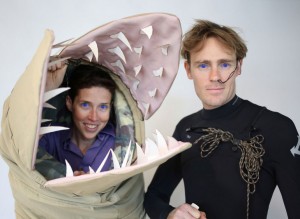Maker-Culture Stars: PopMech Taps Seven MIT Innovators
-
-
slice.mit.edu
Filed Under
Recommended

Maker culture has swept through technology circles, bolstering invention, celebrating hands-on construction, and encouraging do-it-yourselfers—to be more like the MIT community. In fact, seven of the “25 Makers Who Are Reinventing the American Dream” recently honored in Popular Mechanics hail from MIT.
Did their MIT backgrounds play a role?
“My MIT experience was instrumental,” says Ayah Bdeir SM ’06, founder of littleBits, kits of color-coded bricks that snap together to create circuits with sensors, switches, and motors. “As soon as I set foot in the Media Lab, I learnt a whole new way of looking at engineering. That it was a way of thinking and solving problems; that technology was a means to an end; and technology could be a mode of expression, vision, and creativity. And most importantly, that any individual could ‘re-invent’ technology and its impact on the world. These ideas are instrumental to being a maker.”

Eric Wilhelm ’99, SM ’01, PhD ’04, who along with Christy Canida ’99 was honored for their how-to company, Instructables, says his undergraduate living group gave him the opportunity to gain confidence and experience.
“Making things requires practice,” Wilhelm says, “and I had amazing opportunities in my living group to practice cooking, electronics, home repair, and myriad other techniques in an environment where the inevitable failure would result in laughs and a good story.”
Why is maker culture so popular now?
Several factors support maker culture, says Danielle Applestone ’02, who leads Othermill, a producer of $2,000 machines that can etch circuit boards and carve complex 3D shapes. “One of the big ones is that it is extremely easy to not only transfer and distribute digital plans everywhere for free, but you can also get support for making projects much easier than before,” she says. “I think people realize how far removed they are from making tangible things, and so ‘making’ is interesting and novel to the general public. The tools for making things of industrial quality are now becoming more affordable, so that puts the power of manufacturing into the hands of a much larger group of people.”
When Scott Miller SM ’96 earned an ocean engineering degree, being a maker was the only choice. “We had to design and build everything from scratch,” says Miller, head of Dragon Innovation, a firm that helps budding companies scale their ideas to industry size.
Now, he notes, makers have choices and advantages—including lower-cost electrical components, great prototyping tools, and access to cloud computing. Another boost is crowdfunding to generate startup resources and social media to reach millions of potential customers.
Who else was honored?
- Limor Fried ’03, MEng '05, founder of Adafruit Industries, which sells electronic kits with open-source licenses
- Neil Gershenfeld, director of the MIT Center for Bits and Atoms









